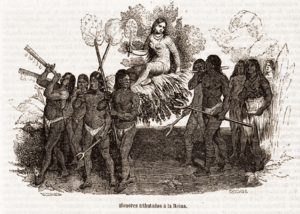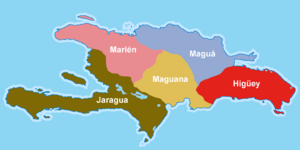Anacaona facts for kids
Quick facts for kids Anacaona |
|
|---|---|

Anacaona
|
|
| Cacica of Xaragua | |
| Reign | 1500 - 1503 |
| Predecessor | Bohechío |
| Born | 1474 Yaguana, Jaragua, Hispaniola (present-day Léogâne, Haiti) |
| Died | c. 1504 Hispaniola |
| Cause of death | Hanging |
| Spouse | Caonabo |
Anacaona (born around 1474, died around 1504) was a powerful Taíno leader. Her name means 'Golden Flower'. She was a cacica, which is a female chief, and also a talented poet and composer. Anacaona was born in Xaragua, one of the five main kingdoms on the island of Ayiti. Today, this island is known as Hispaniola, which includes the countries of Dominican Republic and Haiti.
Anacaona came from a family of chiefs. Her brother, Bohechío, was the ruler of Xaragua. After he passed away, Anacaona became the new cacica. During her time as a leader, the Spanish settlers and the Taíno people in Xaragua lived together peacefully. Some even married each other.
However, in 1503, the island's governor, Nicolás de Ovando, visited Xaragua. He suspected that the Taíno chiefs, including Anacaona, were planning a rebellion. Ovando ordered the chiefs to be captured. Anacaona was later hanged.
Contents
Early Life and Family
Anacaona was born in Yaguana, which is now Léogâne, Haiti, around 1474. Her name comes from the Taíno language. Ana means 'flower', and caona means 'gold' or 'golden'. Her brother, Bohechío, was a local chief who expanded his rule over Xaragua.
To make his kingdom stronger, Bohechío arranged for Anacaona to marry Caonabo. Caonabo was the chief of Maguana, another Taíno kingdom. Anacaona and Caonabo had one daughter named Higüemota.
Arrival of Europeans
On December 4, 1492, Christopher Columbus arrived on the island. He was looking for a direct route to India. The Taíno people welcomed him and gave him gifts like gold and corn. In 1493, the Spanish Crown started a colony there. Their main goal was to find gold and other valuable metals. With the new colony of Santo Domingo, many Taíno people were taken and forced to work as slaves for the Spanish.
In 1493, Anacaona's husband, Caonabo, was arrested. He was accused of destroying a Spanish settlement called La Navidad. Caonabo was sent to Spain but died during the journey when his ship sank. After Caonabo was captured, Anacaona returned to Xaragua. She became an important advisor to her brother, Bohechío.
In 1498, Bartholomew Columbus, Christopher Columbus's brother, arrived in Xaragua. He came with his soldiers to take control of Bohechío's land and find gold. Bohechío's power was weaker, so Anacaona advised him not to fight. Instead, he agreed to accept the rule of the Spanish King and Queen. He promised to pay them with goods like cotton, corn, bread, and fish.
After Bohechío died in 1500, Anacaona became the ruler of Xaragua. She led her people until her death in 1503.

Arrest and Death
In the fall of 1503, Governor Nicolás Ovando traveled to Xaragua with 300 men. Anacaona, her nobles, and other Taíno chiefs welcomed them with a grand ceremony.
The Taíno people saw this as a friendly welcome. However, the Spanish believed it was a trick. Ovando's group thought Anacaona and the Taíno chiefs were planning to rebel. Ovando invited the chiefs into a large hut called a caney for a Spanish event. Then, he gave a signal, and the Spanish soldiers captured and tied up the chiefs. The chiefs were burned inside the hut, while other Taíno people outside were killed.
Anacaona was taken away and later hanged. The place where she was killed was renamed "The City of True Peace" by Nicolás Ovando.
Legacy and Influence
Anacaona is remembered as a poet and composer. She is honored in art and literature across the Caribbean. There is a statue of her in Léogâne, Haiti. The tallest building in the Dominican Republic, Torre Anacaona 27, is named after her. Her story is also told in the popular song "Anacaona," sung by Cheo Feliciano.
Books About Anacaona
- Anacaona: Golden Flower, Haiti, 1490 by Edwidge Danticat (part of The Royal Diaries series)
- Anacaona, la Reine Taino d'Ayiti by Maryse N. Roumain, PhD.
Songs About Anacaona
- "Anacaona" by Ansy and Yole Dérose
- "Anacaona" by Super Sonic de Larose
- "Anacaona" by Eddy Francois
- "Anacaona" composed by Tite Curet Alonso
- "Anacaona" by Irka Mateo
- "Anacaona" sung by Cheo Feliciano
See also
 In Spanish: Anacaona para niños
In Spanish: Anacaona para niños

